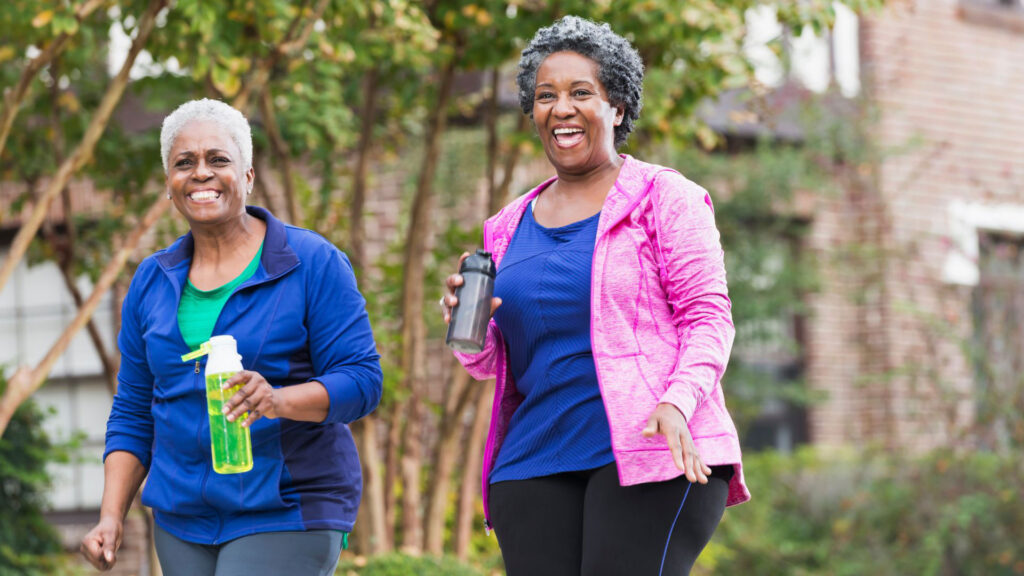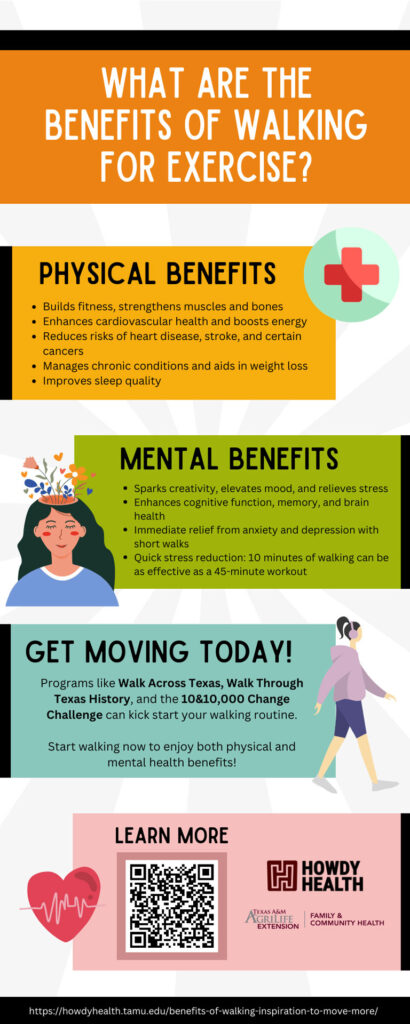Walking for exercise has some amazing health benefits! In fact, studies have shown that walking has the potential for both physical and mental health benefits. Although research is ongoing about the exact frequency, duration, and intensity needed to gain the most benefits, research on walking has demonstrated a myriad of potential physical and mental health benefits.
Physical Health Benefits of Walking
According to research, walking for exercise can result in –
- Increased physical fitness, including strengthening muscle and bones, increasing endurance, and improving balance8,26,28
- Increased cardiovascular and pulmonary (heart and lung) fitness 8,28
- Increased energy levels and reduced fatigue30
- Reduced risk of heart disease,10,25 stroke,12,14 and some cancers20,23
- Reduced risk and/or improved management of chronic conditions, including high blood pressure,15,31 high cholesterol,10,31 diabetes13,19,27,31,32 heart disease,9,31 and joint and muscular pain and stiffness16,26,28
- Reduced body fat10,26,28
- Improved sleep,11,29 including falling asleep faster,11 sleeping longer,11 improved sleep quality, fewer sleep disturbances, and reduced need for sleep medications.29 (All of which play into both our physical and mental well-being.)
Mental Health Benefits of Walking
In addition to the physical health benefits, scientists are starting to uncover many mental health and cognitive benefits of walking for exercise. “Physical health problems significantly increase our risk of developing mental health problems and vice versa. Nearly one in three people with a long-term physical health condition, also has a mental health problem, most often depression and anxiety.”17 Walking can help –
- Increase creativity21
- Boost mood, which could include increased joviality, joy, vigor, attentiveness, self-confidence,18,26 and reduced negative “ruminating” thoughts of self (especially if walking outside in nature)3
- Reduce fatigue30 and improve your mental alertness, energy, and mood17
- Reduce risk of cognitive impairment,6 improve memory,5,24 and prevent the deterioration of brain tissue as we age6
- Increase blood flow to the brain,1,7 which may optimize brain function, and an overall sense of wellbeing during exercise1
- Relieve anxiety2 and depression.4,10,22
Noteworthy…
Some of the mental health benefits from walking may have a more immediate effect, which can be a great motivator to move more.
According to the Anxiety and Depression Association of America, “Psychologists studying how exercise relieves anxiety and depression suggest that a 10-minute walk may be just as good as a 45-minute workout. Some studies show that exercise can work quickly to elevate depressed mood in many people. Although the effects may be temporary, they demonstrate that a brisk walk or other simple activity can deliver several hours of relief, similar to taking an aspirin for a headache.”2
“Scientists have found that regular participation in aerobic exercise has been shown to decrease overall levels of tension, elevate and stabilize mood, improve sleep, and improve self-esteem. About five minutes of aerobic exercise can begin to stimulate anti-anxiety effects.”2
These immediate effects may be just what you need to sit less and move more!
Start your walking routine today. Join Walk Across Texas, Walk Through Texas History, or the 10-10,000 Challenge.
Infographic
Download the PDF or share the image below to help others learn about the benefits of walking for exercise.
- American Association for the Advancement of Science (AAAS). How walking benefits the brain. 24 APR 2017, https://www.eurekalert.org/news-releases/731139
- Anxiety and Depression Association of America. Exercise for stress and anxiety. https://adaa.org/living-with-anxiety/managing-anxiety/exercise-stress-and-anxiety.
- Bratman GN, Hamilton JP, Hahn KS, Daily GC, Gross JJ. Nature experience reduces rumination and subgenual prefrontal cortex activation. Proceedings of the National Academy of Sciences of the United States of America112, no. 28, 2015: 8567–72. https://www.jstor.org/stable/26466002.
- Choi KW, Chen C, Stein MB, et al. Assessment of Bidirectional Relationships Between Physical Activity and Depression Among Adults: A 2-Sample Mendelian Randomization Study. JAMA Psychiatry.2019;76(4):399–408. doi: https://doi.org/10.1001/jamapsychiatry.2018.4175.
- Colmenares AM, Voss MW, Fanning J, Salerno EA, Gothe NP, Thomas ML, McAuley E, Kramer AF, Burzynska AZ. White matter plasticity in healthy older adults: The effects of aerobic exercise, NeuroImage, Volume 239, 2021, 118305, ISSN 1053-8119, doi: https://doi.org/10.1016/j.neuroimage.2021.118305
- Erickson KI, Raji CA, Lopez OL, Becker JT, Rosano C, Newman AB, Gach HM, Thompson PM, Ho AJ, Kuller LH. Physical activity predicts gray matter volume in late adulthood: the Cardiovascular Health Study. Neurology. 2010 Oct 19;75(16):1415-22. doi: https://doi.org/10.1212/WNL.0b013e3181f88359.
- Experimental Biology. How walking benefits the brain: Researchers show that foot’s impact helps control, increase the amount of blood sent to the brain. ScienceDaily. ScienceDaily, 24 April 2017. sciencedaily.com/releases/2017/04/170424141340.htm.
- Garber CE, Blissmer B, Deschenes MR, Franklin BA, Lamonte MJ, Lee IM, Nieman DC, Swain DP; American College of Sports Medicine. American College of Sports Medicine position stand. Quantity and quality of exercise for developing and maintaining cardiorespiratory, musculoskeletal, and neuromotor fitness in apparently healthy adults: guidance for prescribing exercise. Med Sci Sports Exerc. 2011 Jul; 43(7): 1334-59. doi: https://doi.org/10.1249/MSS.0b013e318213fefb.
- HamerM, Chida Walking and primary prevention: a meta-analysis of prospective cohort studies. Br J Sports Med 2008;42:238–43. doi: https://doi.org/10.1136/bjsm.2007.039974.
- Hanson S, Jones A. Is there evidence that walking groups have health benefits? A systematic review and meta-analysis. British Journal of Sports Medicine 2015;49:710-715.
- Hori H, Ikenouchi-Sugita A, Yoshimura R, Nakamura J. Does subjective sleep quality improve by a walking intervention? A real-world study in a Japanese workplace. BMJ Open. 2016 Oct 24;6(10):e011055. doi: https://doi.org/10.1136/bmjopen-2016-011055.
- Hu FB, Stampfer MJ, Colditz GA, Ascherio A, Rexrode KM, Willett WC, Manson JE. Physical activity and risk of stroke in women. JAMA. 2000 Jun 14;283(22):2961-7. doi: https://doi.org/1001/jama.283.22.2961.
- Iwasaki M, Kudo A, Asahi K, Machii N, Iseki K, Satoh H, Moriyama T, Yamagata K, Tsuruya K, Fujimoto S, Narita I, Konta T, Kondo M, Shibagaki Y, Kasahara M, Watanabe T, Shimabukuro M. Fast walking is a preventive factor against new-onset diabetes mellitus in a large cohort from a Japanese general population. Science Reports. 2021 Jan 12;11(1):716. doi: https://doi.org/10.1038/s41598-020-80572-y.
- Jefferis BJ, Whincup PH, Papacosta O, Wannamethee SG. Protective effect of time spent walking on risk of stroke in older men. Stroke, January 2014; 45(1)- 194-199. doi: https://1161/STROKEAHA.113.002246.
- Lee LL, Mulvaney CA, Wong YKY, Chan ES, Watson MC, Lin HH. Walking for hypertension. Cochrane Database of System Reviews. 2021 Feb 24;2(2):CD008823. doi: https://doi.org/10.1002/14651858.CD008823.pub2.
- Lo GH, Vinod S, Richard MJ, Harkey MS, McAlindon TE, Kriska AM, Rockette-Wagner B, Eaton CB, Hochberg MC, Jackson RD, Kwoh CK, Nevitt MC, Driban JB. Association Between Walking for Exercise and Symptomatic and Structural Progression in Individuals with Knee Osteoarthritis: Data from the Osteoarthritis Initiative Cohort. Arthritis Rheumatol. 2022 Jun 8. doi: https://doi.org/10.1002/art.42241.
- Mental Health Foundation. Physical health and mental health. 18 Feb 2022. https://www.mentalhealth.org.uk/explore-mental-health/a-z-topics/physical-health-and-mental-health
- Miller JC, Krizan Z. Walking facilitates positive affect (even when expecting the opposite). Emotion. 2016 Aug;16(5):775-85. doi: 10.1037/a0040270. Epub 2016 Apr 21. PMID: 27100368.
- Myette-Côté É, Durrer C, Neudorf H, Bammert TD, Botezelli JD, Johnson JD, DeSouza CA, Little JP. The effect of a short-term low-carbohydrate, high-fat diet with or without postmeal walks on glycemic control and inflammation in type 2 diabetes: a randomized trial. Am J Physiol Regul Integr Comp Physiol. 2018 Dec 1; 315(6):R1210-R1219. doi: https://doi.org/10.1152/ajpregu.00240.2018.
- National Institutes of Health. Physical activity linked to reduced cancer risk. July 2016. https://newsinhealth.nih.gov/2016/07/physical-activity-linked-reduced-cancer-risk.
- Oppezzo M, Schwartz DL. Give your ideas some legs: The positive effect of walking on creative thinking. Journal of Experimental Psychology: Learning, Memory, and Cognition. Vol. 40. (4), Jul,y 2014 pp. 1142-1152. doi: https://doi.org/10.1037/a0036577.
- Robertson R, Robertson A, Jepson R, Maxwell M. Walking for depression or depressive symptoms: A systematic review and meta-analysis, Mental Health and Physical Activity, Vol 5, Issue 1, June 2012, Pages 66-75, doi: https://doi.org/10.1016/j.mhpa.2012.03.002.
- Saint-Maurice PF, Troiano RP, Bassett DR, et al. Association of Daily Step Count and Step Intensity With Mortality Among US Adults. 2020;323(12):1151–1160. doi: https://doi.org/10.1001/jama.2020.1382.
- Schaefer S, Lövdén M, Wieckhorst, Lindenberger U. Cognitive performance is improved while walking: Differences in cognitive–sensorimotor couplings between children and young adults, European Journal of Developmental Psychology,2010; 7:3, 371-389, doi: https://doi.org/1080/17405620802535666.
- Sheng M, Yang J, Bao M, Chen T, Cai R, Zhang N, Chen H, Liu M, Wu X, Zhang B, Liu Y, Chao J. The relationship between step count and all-cause mortality and cardiovascular events: A dose-response meta-analysis. Journal of Sport and Health Science. December 2021 10(6):620-628. doi: https://doi.org/10.1016/j.jshs.2021.09.004.
- Steinhilber, Briana. Why walking is the most underrated form of exercise. 2 Sept 2017. https://www.nbcnews.com/better/health/why-walking-most-underrated-form-exercise-ncna797271.
- Tudor-Locke C, Schuna JM Jr. Steps to preventing type 2 diabetes: exercise, walk more, or sit less? Front Endocrinol (Lausanne). 2012 Nov 19;3:142. doi: 10.3389/fendo.2012.00142
- Victoria State Government Department of Health. Walking for Good Health., 30 June 2015 https://www.betterhealth.vic.gov.au/health/healthyliving/walking-for-good-health.
- Wang, F., Boros, S. The effect of daily walking exercise on sleep quality in healthy young adults. Sport Sci Health17, 393–401 (2021). doi: https://doi.org/10.1007/s11332-020-00702-x.
- Wennberg P, Boraxbekk C, Wheeler M, Howard B, Dempsey PC, Lambert G, Eikelis N, Larsen R, Sethe P, Occleston J, Hernestal-Boman J, Ellis KA, Owen N, Dunstan DW. Acute effects of breaking up prolonged sitting on fatigue and cognition: a pilot study. BMJ Open 2016; 6:doi: https://10.1136/bmjopen-2015-009630.
- Williams PT, Thompson PD. Walking versus running for hypertension, cholesterol, and diabetes mellitus risk reduction. Arterioscler Thromb Vasc Biol. 2013 May;33(5):1085-91. doi: https://1161/ATVBAHA.112.300878.
- Yates T, Edwardson CL, Celis-Morales C, Biddle SJH, Bodicoat D, Davies MJ, Esliger D, Henson J, Kazi A, Khunti K, Sattar N, Sinclair AJ, Rowlands A, Velayudhan L, Zaccardi F, Gill JMR. Metabolic Effects of Breaking Prolonged Sitting With Standing or Light Walking in Older South Asians and White Europeans: A Randomized Acute Study. J Gerontol A Biol Sci Med Sci. 2020 Jan 1;75(1):139-146. doi: https://10.1093/gerona/gly252.






